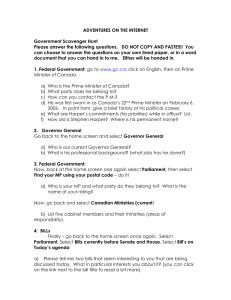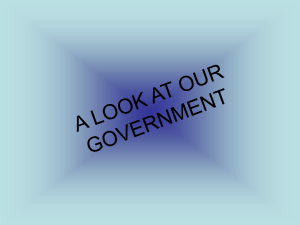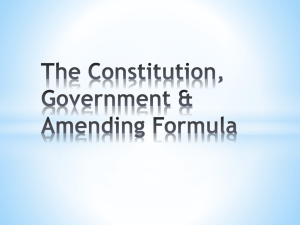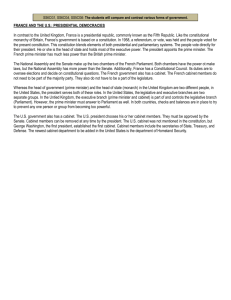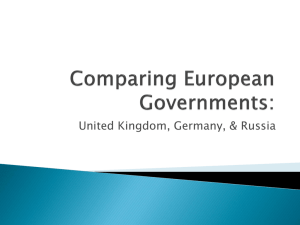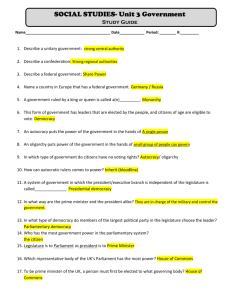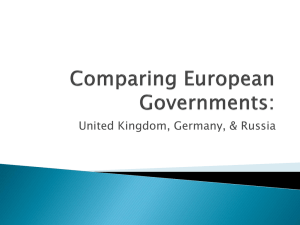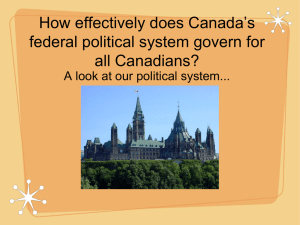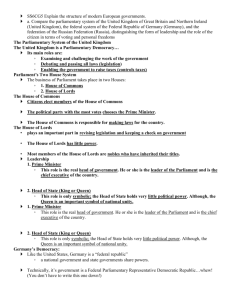Canadian Government
advertisement
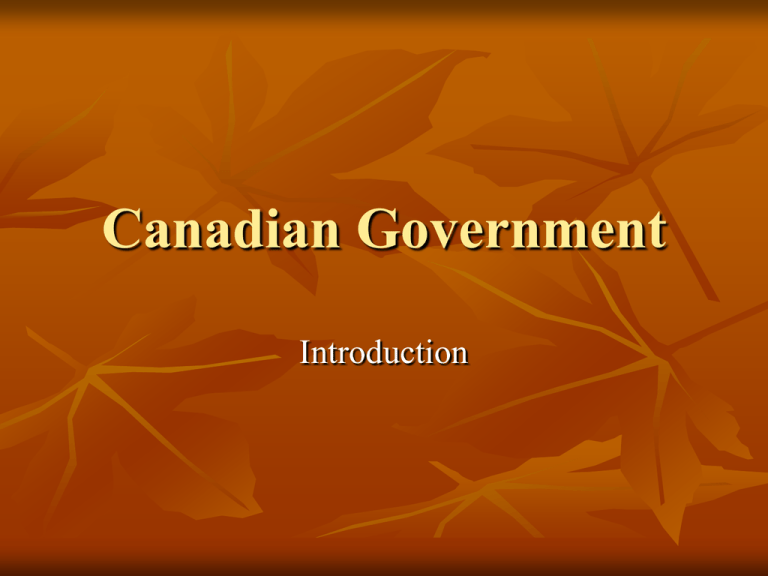
Canadian Government Introduction What is a Government? One of the oldest and most important institutions since the dawn of civilization is government. The term government means a group which exercises power. Every society needs people to make decisions and enforce decisions that affect the conduct of the group. Elements of Governments There are a number of common elements found in all governments. They are: Rules of Conduct: Rules to govern the lives of its members. Authority: The people are governed by a supreme power or authority. Acceptance: The people give the government the right to exercise power. Jurisdiction: The area over which the government had the right or power to enforce rules or laws. Law Enforcement: The power and ability to impose the government’s rules and laws. Types of Government Anarchism: The absence of government. The people believe that the government conflicts with personal liberty and are unnecessary. They would get rid of all public governments and lets only individuals and private groups govern the activities of a country. Just as many people view this type of government as Chaos as those who see it as Utopia. Either way, this type of government has proved ineffective for growth and development Dictatorship: When a ruler or rulers have no restrictions on their power. They have exclusive control over the government and the people have little to no say in the running of the country. A dictator usually obtains and maintains their power through violence and trickery. Totalitarianism: An extreme version of dictatorship when the government not only controls the running of the country, but also the daily lives of it’s citizens. They destroy institutions like churches, unions, and corporations and demand total loyalty to the government. They use force and terrorism to enforce their rule. Communism: The government is tightly controlled by one, and the only, political party. There is no freedom of choice for the leaders and the people have little to no say in the running of the government. The Communist Party’s job is to run the businesses, pool resources, and decide who gets what. There are no private enterprises and many restrictions on what citizens can own, what groups they can belong to, and what they can say and do. Monarchy: A form of government in which the head of state inherits or is elected to the throne for a lifetime. Monarchs have a variety on names such as queen, prince, emperor, ni a variety of governments. Traditionally the monarch’s power is absolute and was responsible only to God. Today many remaining monarchs’ power is symbolic, leaving the running of their countries to the various governing bodies. Democracy: In a direct democracy, the people govern themselves. They make laws for theitr community together. However this only works in small communities where everyone has a direct voice in decisions made. Larger communities have indirect democracy. Representatives are elected by communities to represent them when decisions are made by the government. They are elected by a vote. In a democratic country, people have almost unlimited opportunities to make the government truly representative. Many people take part in the process of their government by supporting a political party. Political parties run against each other. The party who gets the most votes by the citizens generally create the government. A democratic government with a capitalist or mixed economy has provided greater prosperity for more people without major sacrifices of personal liberty than any other system of government. Pluralism: is found in countries where public and private groups have acceptance and can affect the way a country is run. Groups representing business, farming, labour, ethnic, or racial groups can affect the way a country is run. Constitutional and Parliamentary: Most major countries have some sort of constitution in place. It is a basic set of laws by which the people are governed. Parliamentary or cabinet governments means the country is governed by a representative group. In Canada, the Prime Minister and Cabinet are the top executives but and also members of parliament- they are under its direct control and are responsible to it. A country can be run under a parliamentary government that abides by a constitution. Questions Why does Canada need a gov’t system? What are the pros and cons of the Canadian gov’t system? If you had to change our gov’t to a different system, which system would you choose and why? Function of Government A government is the machinery set up by individuals to enable them to do what other cannot do on their own. Without some form of government there would be no order or protection for people and their property. A government’s basic task is to make a set of laws to allow people in a society to live together in peace and security. A government also makes sure laws are obeyed and sets up punishment or penalties that protect the interests of the people as a whole against the greed or ambition of any one person or group. Tasks There are many different kings of governments but they all carry out three main tasks or functions. They are legislative, executive, and judicial. The legislative function is the making of laws or the passing of legislation. The executive function is putting the laws into effect on a daily basis. The judicial function is to decide if an individual has broken societal laws and to bring justice. Canada’s Government The government of Canada has been described as a democracy, a monarchy, a parliamentary system, a cabinet government, and a federal government. Canada is considered a democracy because we use a system where the citizens of the country freely choose the people who will govern them. We elect others to represent us in governing the country by voting. Canada’s government has also been described as a monarchy. We are still part of the British Commonwealth; therefore, Queen Elisabeth II of England is also the queen of Canada. She is represented by the governor general. Even though they are technically at the top of the governmental hierarchy, neither the Queen nor the Governor General play a major role in our government. Canada’s government has also been described as a parliamentary government and a cabinet government. Our parliament consists of the Governor General, the Senate, and the House of Commons. The Cabinet consists of members of the House of Commons or Senate who are elected by the Prime Minister into the Cabinet in order to deal with the many issues facing Canadians today. Our government is also referred to as a federal system of government. This means our government has a system in which the power to make laws is shared between two levels of government- a national or central government (federal) and provincial governments. Within the provinces, there are municipal governments that look after towns and/or districts. All three work independently for the common good of all of Canada. Canada’s Government Questions: What is overall the function of the government? What is the function of the Governor General? What are the three levels of the Canadian government? The Prime Minister The head or leader of Canada is called the Prime Minister. He or she is also the leader of the majority party in the House of Commons and id directly elected by the people. The office of the Prime Minister has no fixed term. However, general elections are held every five years. The Prime Minister holds office only with the backing of the majority. If a Prime Minister loses support through a vote of non confidence by the House of Commons, he/she must resign to request the Governor General to call a new general election. Well Known Prime Ministers of Canada Sir John A Macdonald 1867- 1873 Sir Wilfred Laurier 1911- 1917 John G Diefenbaker 1957-1963 Pierre Elloitt Trudeau 1968-1979 1980- 1984 John Chrétien 1993- 2003 The Prime Minister is the most powerful person in the government, He/she chooses the Ministers for the Cabinet and can also ask any one of them to resign. Cabinet decisions do not necessarily go by majority vote. A strong Prime Minister, after having listened to everyone’s opinions and advice, simply announces that his or her view is the policy of the government, even if most of the Cabinet are opposed. The Cabinet Ministers who are opposed either resign or accept the Prime Minister’s decision. The Prime Minister lives in an official residence in Ottawa Ontario. The house is maintained by the Canadian Government. Prime Minister’s House in Ottawa, Ontario The Cabinet The Prime Minister’s Cabinet is made up of approx. 30 ministers. These ministers are chosen by the Prime Minister from the majority party in the House of Commons. The Cabinet is a powerful part of the Canadian Government It is important because it is the executive of the country. The Cabinet and the Prime Minister decide the policies the Government will follow. Each province must be represented by at least one minister. Each minister is given a portfolio which means that he or she is responsible for a government department. Each minister also has a deputy minister who is a permanent head of the department. Backbenchers Members of the governing party who are not in the cabinet are called backbenchers because their seats in the House of Commons are behind those of the Cabinet Minister. Cabinet Ministers must convince the other members of their party in the House of Commons that the policies proposed by the Cabinet are the right ones. The backbenchers want to be able to support government or Cabinet policies but they do not want to see the party adopt policies that go against the wishes of the people who have elected them. This is why the proposal of new bills and policies is a delicate operation. Parliament On January 1, 1858, Queen Victoria declared Ottawa to be the capital of Canada. Barracks Hill was chosen as the site of the future government buildings because of its view of the Ottawa River. On September 1, 1860 the Prince of Wales laid the cornerstone. The building is made up of several different sections including The Parliament Centre Block that holds the House of Commons and the Senate, the Confederation Hall which is the most lavishly adorned, The Great Hall of Honour which holds marble carvings that commemorate events and distinguished Canadians, The Peace Tower which is revered as one of the finest gothic structures in the world. It holds 53 bells that honor the soldiers that lost their lives in WWI. There is also the Memorial Chamber, and the gothic parliament library which holds rare bibles, war documents, and thousands of books dating back to 1764. Parliament before the fire of 1916 Parliament and the Changing of the Guards Parliament overlooking the Ottawa River Above: Entrance Hal Below: Parliament Library House of Commons Senate Chambers Parliament Parliament consists of the Queen represented by the Governor General, the Senate, and the House of Commons. The upper house is called the Senate and the lower house is called the House of Commons. Members of Parliament or of a Provincial Legislature are normally elected for no more than five years. The House of Commons The House of Commons or Lower House has 308 seats. Members of the house are elected by the people during an election. Each member of the house represents a constituency (district) of a province of territory. Parliament sits about 27 weeks of the year. Sitting starts in September and usually continues until June which breaks to permit the house members to work in their regions or ridings. Parliament begins with a speech from the throne made by the Governor General and ends by being dissolved. Members of Parliament An MP is a federal representative who represents people who live in a voting area called a constituency. The number of federal representatives is affected by the changes in population. The MPs from all over Canada form a group called the House of Commons. All the MPs meet in the Parliament Building in Ottawa and talk about the country’s business and things that affect the people. An good MP learns about Canada’s problems and how to solve them. An MPs main job is to inform their constituents about new laws and policies and how they may affect them. They report to their constituents through meetings, phone calls, letters, newsletters, and often an internet website. They travel from Ottawa to their constituency several times a year. Each sitting in Parliament has its own agenda. On the agenda will be routine business, committee reports, Minister’s Statements, presentations of petitions, introduction of bills and debating legislation. The best part of each day’s sitting is the Question Period. Here the Members of the House can ask the ministers all kids of question about their departments and policies. Question Period can get rather heated. It is the Speaker of the House’s job to make sure the members of the House follow parliamentary rules and behave themselves in the House. Canadian Constituencies Area Seats Ontario 106 Quebec 75 British Columbia 36 Alberta 28 Manitoba 14 Saskatchewan 14 Nova Scotia 11 New Brunswick 10 NFLD 7 PEI 4 Northwest Territories 1 Yukon Territory 1 Nunavut 1 TOTAL 308 Question Period The Senate The Senate or Upper House is made up of 104 men and women. The members are appointed by the Governor General on the recommendation of the Prime Minister. Usually an appointment to the Senate is given as a reward for service to the country. Senators must be at least 30 to be appointed and must retire at 75. They must reside in the province or territory for which they are appointed and own real estate worth $4000. The Senate is made up of members who have specialized knowledge and long years of legal, business and/or administrative experience. They may be ex-premiers, exmayors, lawyers or experienced farmers. The Senate can initiate bills, amend bills, or reject bills as often as they see fit. No bill can become law unless it has been passed by the Senate. The Senate rarely rejects bills but often makes amendment to bills passed by the House of Commons to simplify or clarify. The Senate carefully examines each bill clause by clause. It has also taken on the role investigating important public problems such as poverty, unemployment, inflation, the aged, land use, science policies, aboriginal affairs, relations with the U.S, and the efficiency (or lack of it) of government departments. The Senate Chamber The throne and chair in the background are used by the queen and her consort, or the governor general and his or her spouse, respectively, during the opening of Parliament. The speaker of the Senate employs the chair in front. Senators
